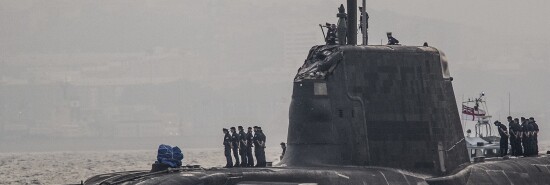
UK navy admiral helps US with contingency force posture
Tom Rogan
Video Embed
The head of the Royal Navy has rightly underlined why warfighting capability and warships at sea do not necessarily go hand-in-hand. Testifying before the British Parliament’s defense committee last week, Sir Ben Key defended a balance of naval deployments with holding other warships in port at high readiness.
Key’s military rank is “First Sea Lord,” a title reflecting Britain’s long naval history. And this First Sea Lord is well-regarded in the United Kingdom and the United States as a smart, capable leader. But like his U.S. Navy counterpart Adm. Lisa Franchetti, Key faces a challenge in balancing warship availability with national defense needs. The U.K. has avoided some but certainly not all of the industrial failure that has recently defined the U.S. Navy.
THANKSGIVING TRAVELERS SET TO CLOG SKIES AND ROADS IN HISTORICALLY BUSY TRAVEL SEASON
The problem in the U.K. has primarily been that of deep defense budget restrictions. In contrast, the problem in the U.S. has been cronyism. Too many in Congress, including members who know better, such as Rep. Mike Gallagher (R-WI), have made the Navy build and keep ships it doesn’t want. Littoral Combat Ships offer a standout example here. In those rare moments when they are not being repaired, the LCSs serve as coral reefs in waiting for China’s People’s Liberation Army. The U.S. also suffers from a broken naval industrial base, including catastrophic submarine construction schedules. Making matters worse, we now face the passage of profoundly idiotic legislation from Sen. Tammy Baldwin (D-WI) that would worsen warship construction delays and costs while alienating key allies.
Yet delays to the construction of Astute-class attack submarines and new Type 26 anti-submarine warfare frigates mean that Key now has only 22 deployed/deployable surface combatants/attack submarines. Key must thus balance deployment presence with maintaining “high readiness” forces to deploy in a crisis. But maintaining high readiness forces is made a lot more challenging when ships are deployed on routine operations. After all, each deployment inevitably must be followed by maintenance periods in which ships aren’t functionally usable. This leads to hard choices.
Asked by Mark Francois, a member of Parliament, whether it was embarrassing that not one attack submarine was deployed at one point in August, Key rejected that argument. Noting a “very sophisticated” effort led by the U.S. and the U.K. to monitor Russian submarines in the Atlantic (no small concern), Key suggested crisis flexibility was paramount. Asked by Francois whether he could put three of the six attack submarines to sea in a crisis, Key responded, “I can put three to sea, I’m absolutely sure, that’s half the fleet. … Whether I need to do so or not, that’s a different matter.” Key also said he could put a mix of eight to nine frigates and destroyers to sea at very short notice.
From a U.K. prestige perspective, the relative absence of warships from deployments might be problematic. From a U.K. and U.S. crisis readiness perspective, however, Key’s posture is welcome.
The U.K.’s two new aircraft carriers are exceptionally well integrated with the U.S. Navy (even hosting U.S. Marine fighter squadrons). The Royal Navy’s Type 45 air defense destroyers and Astute submarines also train very closely with U.S. forces and are exceptionally capable. They would be particularly valuable when operating against saturated Chinese air and anti-ship missile forces. While such an operation would obviously require London’s political directive (a separate and significant U.S. concern), Key’s ability to put scaled capability to sea during a crisis is of key value to the U.S. Considering the rapidly escalating scale, skill, and aggression of the PLA, any prospective U.K. naval support in a conflict with China would be highly valuable.
This is a concern of today, not the near-term future.
Tensions between the U.S. and China are now persistent in the Taiwan Strait and growing rapidly in the South China Sea. The U.S. Navy has just begun a joint patrol with the Philippines in waters that China unjustly claims. Chinese coast guard vessels are escalating their use of water cannons and ramming tactics against Philippine vessels in these waters. Considering that Manila is a U.S. defense treaty ally, the potential for its escalation with Beijing leading to a U.S.-involved conflict is no small concern. And that’s before we consider the potential of miscalculation.
Put simply, then, Key’s force posture should be welcomed in Washington. He is showing his respect for an unpredictable world and his value for the special relationship.
